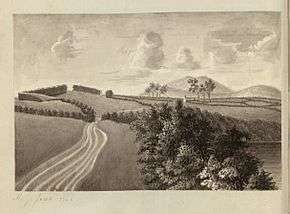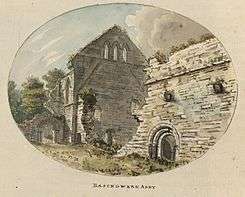Moses Griffith (artist)
Moses Griffith (6 April 1749 – 11 November 1819) was a Welsh draughtsman, engraver and watercolourist.


Griffith was born 6 April 1749 at Trygain House in the parish of Bryncroes on the Llŷn Peninsula, Caernarfonshire. His parents were of humble station, and he received a very elementary education but, being clever with his pencil, he was taken into service by Thomas Pennant[1] about 1769. Pennant helped him to study drawing and engraving, and Griffith became his constant companion on his tours and excursions, making the drawings and engravings for Pennant's numerous works. Griffith became proficient both as a draughtsman and as an engraver.
On leaving Pennant's service he settled at Wibnant, near Holyhead, where he obtained plenty of employment as an engraver. He was alive in 1809, when he wrote a letter defending himself from an attack to the Gentleman's Magazine.[2] Francis Grose employed Griffith to engrave some of the plates in his Antiquities.
Griffith also painted watercolours of Welsh scenes, churches, country houses, and portraits, including two self-portraits.
Works
 An original watercolour of Clynnog by Griffith (1782), from the National Library of Wales' extra-illustrated set of A Tour in Wales.
An original watercolour of Clynnog by Griffith (1782), from the National Library of Wales' extra-illustrated set of A Tour in Wales..jpg) Lobelia dortmanna drawn by Griffith, engraved by Peter Mazell, from John Lightfoot's 1777 Flora Scotica
Lobelia dortmanna drawn by Griffith, engraved by Peter Mazell, from John Lightfoot's 1777 Flora Scotica "Long Leg'd Plover" (black-winged stilt) in Flora Scotica, one of a few birds in the book. Drawn by Moses Griffith; engraved by Peter Mazell
"Long Leg'd Plover" (black-winged stilt) in Flora Scotica, one of a few birds in the book. Drawn by Moses Griffith; engraved by Peter Mazell A miniature of Basingwerk Abbey from a unique set of eight extra-illustrated volumes of Thomas Pennant's A Tour in Wales owned by the National Library of Wales.
A miniature of Basingwerk Abbey from a unique set of eight extra-illustrated volumes of Thomas Pennant's A Tour in Wales owned by the National Library of Wales. Another image of Basingwerk Abbey from Pennant's A Tour in Wales.
Another image of Basingwerk Abbey from Pennant's A Tour in Wales.
References
- Oxford University Press (21 June 2012). Benezit Dictionary of British Graphic Artists and Illustrators. OUP USA. p. 493. ISBN 978-0-19-992305-2.
- Gent. Mag. 1809, pt. ii. 1112
![]()